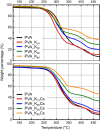Extraction of γ-chitosan from insects and fabrication of PVA/γ-chitosan/kaolin nanofiber wound dressings with hemostatic properties
- PMID: 38693438
- PMCID: PMC11063014
- DOI: 10.1186/s11671-024-04016-6
Extraction of γ-chitosan from insects and fabrication of PVA/γ-chitosan/kaolin nanofiber wound dressings with hemostatic properties
Abstract
A nanofiber-based composite nonwoven fabric was fabricated for hemostatic wound dressing, integrating polyvinyl alcohol (PVA), kaolin, and γ-chitosan extracted from three type of insects. The γ-chitosan extracted from Protaetia brevitarsis seulensis exhibited the highest yield at 21.5%, and demonstrated the highest moisture-binding capacity at 535.6%. In the fabrication process of PVA/kaolin/γ-chitosan nonwoven fabrics, an electrospinning technique with needle-less and mobile spinneret was utilized, producing nanofibers with average diameters ranging from 172 to 277 nm. The PVA/kaolin/γ-chitosan nonwoven fabrics demonstrated enhanced biocompatibility, with cell survival rates under certain compositions reaching up to 86.9% (compared to 74.2% for PVA). Furthermore, the optimized fabric compositions reduced blood coagulation time by approximately 2.5-fold compared to PVA alone, highlighting their efficacy in hemostasis. In other words, the produced PVA/kaolin/γ-chitosan nonwoven fabrics offer potential applications as hemostatic wound dressings with excellent biocompatibility and improved hemostatic performance.
Keywords: Electrospinning; Hemostasis; Kaolin; Oral wound dressing; Polyvinyl alcohol; γ-chitosan.
© 2024. The Author(s).
Conflict of interest statement
The authors declare that they have no competing interests.
Figures







Similar articles
-
Kaolin-loaded chitosan/polyvinyl alcohol electrospun scaffold as a wound dressing material: in vitro and in vivo studies.J Wound Care. 2020 May 2;29(5):270-280. doi: 10.12968/jowc.2020.29.5.270. J Wound Care. 2020. PMID: 32421483
-
Electrospun kaolin-loaded chitosan/PEO nanofibers for rapid hemostasis and accelerated wound healing.Int J Biol Macromol. 2022 Sep 30;217:998-1011. doi: 10.1016/j.ijbiomac.2022.07.186. Epub 2022 Jul 28. Int J Biol Macromol. 2022. PMID: 35907464
-
Wound dressing based on nonwoven viscose fabrics.Carbohydr Polym. 2012 Sep 1;90(1):658-66. doi: 10.1016/j.carbpol.2012.05.093. Epub 2012 Jun 1. Carbohydr Polym. 2012. PMID: 24751090
-
Production and Application of Biomaterials Based on Polyvinyl alcohol (PVA) as Wound Dressing.Chem Asian J. 2022 Nov 2;17(21):e202200595. doi: 10.1002/asia.202200595. Epub 2022 Sep 19. Chem Asian J. 2022. PMID: 36066570 Review.
-
Chitosan Hemostatic Dressings: Properties and Surgical Applications.Polymers (Basel). 2024 Jun 22;16(13):1770. doi: 10.3390/polym16131770. Polymers (Basel). 2024. PMID: 39000626 Free PMC article. Review.
Cited by
-
Electrospun Nanofibers from Plant Natural Products: A New Approach Toward Efficient Wound Healing.Int J Nanomedicine. 2024 Dec 27;19:13973-13990. doi: 10.2147/IJN.S501970. eCollection 2024. Int J Nanomedicine. 2024. PMID: 39742091 Free PMC article. Review.
-
Research Advances in Electrospun Nanofiber Membranes for Non-Invasive Medical Applications.Micromachines (Basel). 2024 Sep 30;15(10):1226. doi: 10.3390/mi15101226. Micromachines (Basel). 2024. PMID: 39459100 Free PMC article. Review.
-
Impact of Edible Insect Polysaccharides on Mouse Gut Microbiota: A Study on White-Spotted Flower Chafer Larva (Protaetia brevitarsis seulensis) and Silkworm Pupa (Bombyx mori).Foods. 2024 Dec 24;14(1):6. doi: 10.3390/foods14010006. Foods. 2024. PMID: 39796296 Free PMC article.
References
-
- Hamad K, Kaseem M, Yang HW, Deri F, Ko YG. Properties and medical applications of polylactic acid: a review. Express Polym Lett. 2015;9:435. doi: 10.3144/expresspolymlett.2015.42. - DOI
-
- Jem KJ, Tan B. The development and challenges of poly(lactic acid) and poly(glycolic acid) Adv Ind Eng Polym Res. 2020;3:60. doi: 10.1016/j.aiepr.2020.01.002. - DOI
Grants and funding
LinkOut - more resources
Full Text Sources
Miscellaneous
